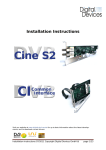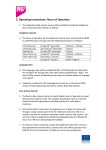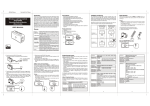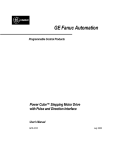Download Manual - Tecatel
Transcript
REMOTEC TRANSMISOR INALÁMBRICO DE MANDOS A DISTANCIA MANUAL DE USUARIO Importante-Instrucciones de seguridad • Para evitar riesgo de incendio o electrocución, no exponga este producto a la lluvia o humedad. • Para evitar una descarga eléctrica, no abra el producto. • Este producto debe de utilizarse con el voltaje indicado en la fuente de alimentación. • No sobrecargue las tomas de corriente, ni los cables prolongadores, ya que pueden producir un incendio o una descarga eléctrica. • En caso de avería acuda al servicio técnico. Precaución: Los cambios o modificaciones que no hayan sido realizados por personal autorizado, anularán la garantía. A. Contenido de la caja Verifique que todos los componentes que se detallan a continuación están en la caja del producto. Si le falta alguno, contacte con su distribuidor tan pronto como le sea posible. 1.Transmisor 2.Receptor ×1 ×1 Nota: Este equipo ha sido probado y cumple con los límites para dispositivos de clase B, perteneciente a la parte 15 de las normativas de FCC. Estos límites están diseñados para proporcionar protección contra interferencias dañinas en una instalación doméstica. Este equipo genera señales de radiofrecuencia; si no se instala y se utiliza siguiendo estas instrucciones, puede causar interferencias dañinas a las comunicaciones de radio. No obstante, no hay ninguna garantía de que no aparezcan interferencias en una instalación doméstica. Si este equipo causa interferencias a la radio o a la recepción de la TV, que puede ser detectado encendiendo o apagando el equipo, se recomienda al usuario intentar corregir esta interferencia de la siguiente forma: 3.Receptor de infrarrojos para conectar en el panel trasero del receptor ×1 4. Adaptador de corriente 230VAC to 9VDC Jack 9VDC 150mA • Reoriente o cambie de sitio la antena terrestre. • Incremente la separación entre el equipo y el receptor. • Conecte el equipo a una toma en un circuito diferente al que está conectado el receptor. 1 2 ! ×2 C. Panel de control y características B. Consideraciones 1. La toma de corriente del alimentador ha de tener el mismo voltaje que la del suministro eléctrico. 2. Verifique que el transmisor y el receptor están conectados a la fuente de alimentación. 3. Caso de que dos o más equipos estén funcionando simultáneamente en un perímetro de 30 metros, puede existir conflictos. 4. Evite utilizar junto con otros productos que utilicen frecuencias similares. 5. Asegúrese que la distancia del infrarrojo del Transmisor al Mando a distancia y la del infrarrojo del Receptor al Dispositivo a controlar es la correcta, tal y como se indica en los siguientes apartados. 6. El LED del receptor y del transmisor parpadearán al recibir la señal del mando a distancia. Las siguientes ilustraciones muestran los nombres de cada componente en el receptor y el transmisor. Vista frontal del transmisor y del receptor Receptor de infrarrojos Ventana del mando a distancia Vista trasera del transmisor y del receptor Precaución: Si el LED del receptor parpadea cuando el transmisor no está en funcionamiento, indica que hay una interferencia. extensor IR Entrada del adaptador de corriente (9VDC) Entrada del adaptador de corriente (9VDC) Antena 3 Antena 4 D. Funcionamiento El transmisor de mandos a distancia le da la posibilidad de controlar cualquier dispositivo que se controle mediante infrarrojos utilizando el mando a distancia original. El transmisor convierte las señales infrarrojas (IR) emitidas por el mando a distancia a radiofrecuencia (RF) en banda UHF y las envía al receptor donde la señal RF se vuelve a convertir en la original IR y se envía a la fuente de audio/vídeo a controlar. Hay dos formas de utilizar el transmisor de mandos a distancia: Utilización del cable extensor de infrarrojos El cable extensor de infrarrojos se conecta al receptor a través de la clavija IR. Este cable emite la señal de infrarrojos al dispositivo en cuestión. Para un correcto uso siga los siguientes pasos: 1. Conecte el cable extensor de infrarrojos a la parte posterior del receptor. 2. Oriente los extremos del cable extensor apuntando a los dispositivos a controlar. Fije el cable extensor en la posición correcta para evitar que éste se mueva. 3. Caso de no utilizar el cable extensor asegúrese que el receptor apunte directamente al receptor de infrarrojos del dispositivo a controlar. 1.Sitúe el infrarrojo del receptor frente al dispositivo a controlar. 2.Caso de no poder situar el infrarrojo del receptor en frente del dispositivo a controlar, conecte al receptor el cable de infrarrojos (IR), extiéndalo y sitúelo frente a los dispositivos a controlar. 5 6 E. Incidencias, cuidados y mantenimiento Lea detenidamente este manual y siga los pasos. Si aun así tiene dificultades consulte la siguiente tabla para buscar soluciones a los problemas más comunes. Problema El extensor de mandos a distancia no funciona correctamente Posible solución • Verifique que no haya objetos entre el receptor y el dispositivo a manejar. • Verifique si la ventana de infrarrojos (situada en la parte frontal superior) está obstruida. • Ajuste las antenas del REMOTEC. Note: Limpie el plástico del exterior con un trapo suave y ligeramente humedecido con agua. No use nunca productos químicos. F. Especificaciones Transmisor Nivel de salida de RF Frecuencia de operatividad Alimentación Dimensiones Peso 80dBμV/m, a 3 metros 433.92 MHz 9VDC, 150mA 79mm x 71mm x 26mm 40g Receptor Sensibilidad del receptor Frecuencia del receptor Alimentación Dimensiones Peso -85 dBm 433.92 MHz 9VDC, 150mA 79mm x 71mm x 26mm 40g Sistema Rango de temperatura de operatividad Distancia de control remoto 0 ~50 Hasta 75 metros • Todas las especificaciones están sujetas a cambios sin previo aviso 8 7 REMOTEC IR REMOTE CONTROL EXTENDER OWNER'S MANUAL Important-Safety Precautions • To prevent fire or shock hazard, do not expose this product to rain or moisture. do not use near a bathtub, wash bowl, kitchen sink, or laundry tub, in a wet basement, or near a swimming pool. • To avoid electrical shock, do not open this product. • This product should be operated to use the power supply must have the same voltage as the local area. • Do not overload wall outlets and extension cords as this can result in the risk of fire or electrical shock. • Refer servicing to qualified personnel only. Caution: Changes or modifications not expressly approved by the Party responsible for compliance could avoid the user’s authority to operate the equipment. A. Checking Contents of Box Check to ensure all of the components shown as below are included with your wireless IR remote control extender system. If something is missing, please contact your dealer as soon as possible. 1. Transmitter ×1 2. Receiver ×1 3. IR extender to connect to receiver’s rear panel ×1 Note: This equipment has been tested and found to comply with the limits for a Class B digital device, pursuant to part 15 of the FCC Rules. These limits are designed to provide reasonable protection against harmful interference in a residential installation. This equipment generates, uses and can radiate radio frequency energy and, if not installed and used in accordance with the instruction, may cause harmful interference to radio communications. However, there is no guarantee that interference will not occur in a particular installation. If this equipment does cause harmful interference to radio or television reception, which can be determined by turning the equipment off and on, the user is encouraged to try to correct the interference by one or more of the following measures: 4. Power adapter 230VAC to 9VDC DC in Jack (9V 150mA) • Reorient or relocate the receiving antenna. • Increase the separation between the equipment and receiver. • Connect the equipment into an outlet on a circuit different from that to which the receiver is connected. 2 1 ! ×2 C. Panel Controls and Features of Universal Type B. The Using Attention 1. The outlet of the power supply must have the same voltage as the local area. 2. Be sure the transmitter and the receiver were connected to power supply. 3. In some situation, there are two or more equipment is used within 100 feet at the same time, perhaps the equipment may not work well. 4. Please do not use another one which operation frequency is similar to when the equipment is working . 5. To make the remote control face to the transmitter’s IR Remote control window, and the receiver’s IR remote control window (or extender accessory) to the source equipment, the IR remote distance should be in the Specifications range. 6. The LED of the receiver and the transmitter’s IR remote control window would flash if receiving the remote control signal when there is not harmful interference in the ambient. Caution: If the receiver’s indication LED flash when the transmitter is not operating. It indicates there is interference in the ambient. Then perhaps, you can’t control the system so well. The following illustrations show the names component on the transmitter and receiver. each FRONT VIEW FOR TRANSMITTER AND RECEIVER infrared passes through this to remotely control audio/video source Remote control window REAR VIEW FOR TRANSMITTER AND RECEIVER IR extend DC power input, connect to Power adapters (9VDC) DC power input, connect to Power adapters (9VDC) UHF antenna receivers Remote control signal 4 3 of UHF antenna sends Remote control signal D. How to Use the IR Remote Control Extender This IR remote control extender will gives you the ability to control the source using your existing remote control device. It converts the infrared (IR) signal emitted by your remote control to a radio frequency (RF) signal in UHF band at the transmitter and sends it back to the receiver where the RF signal is converted back to the original IR signal and beamed to the audio/video source. There are two means to make your source A/V equipment can be controlled well by existing remote control through IR remote control extender. 1. To orient the receiver unit face to face the source A/V equipment, this would allow the converted IR signal which from receiver IR remote control window be able to send to the source A/V equipment(s) front panel. 2. Simply connect an IR extender accessory from receiver and locate this IR extender accessory near the source A/V equipment from panel. How To Use The IR Extender Accessory The IR extender accessory was connected to the receiver through its own special Connector plug. The extender accessory emits an IR signal, bathing your AV equipment with the remote signal. To use the IR extender accessory, follow the instructions below: 1. Plug the IR extender into the receiver in rear panel. 2. Orient the end of the IR extender so that it points in the general direction of the IR sensors of the source AV equipment you wish to be controlled. Cut a length of provided fastener strip to secure the IR extender, which is always in it’s position. 3. Position the receiver so that your remote control signal can strike the IR window on the bottom front of the unit. To use your remote control, point it at the front of the receiver. Occasionally it may be difficult or even impossible to orient the receiver unit such that it can be "seen" (means face-toface) by the A/V equipment you wish to control. Perhaps there is no good surface that allows for this or perhaps you wish to control. Or perhaps you wish to remotely control A/V equipment’s in different locations without re-orienting the receiver, in this case, to use in extender accessory will be more convenient. 5 6 E. Troubleshooting , Care and Maintenance Please read this owner's manual carefully and follow the steps described in it. If you still have difficulties, consult the following table. It will guide you though the most common problems and their solutions. Problem Remote control extender does not work Possible solution • Check the path between the receiver and the audio/video source and clear any obstructions. • Check to see if the IR window on the top front of the receiver is blocked. • Make sure IR extender accessory is properly rotated in the A/V equipment you wish to control. ( see section on "How to use the IR Remote Control extender" in this manual) • Adjust remote control antennas. Note: Clean the outside plastic packaging with a soft cloth lightly moistened with mild soap and water. Never use any abrasive scouring powder or solvent. F. Specifications Transmitter RF output Level Operation frequency PowerSupply Dimension Weight 80dBμV/m,at 3meter 433.92MHz 9VDC 150mA 79mm×71mm×26mm 40g Receiver Receive Sensitivity Receive frequency Power Supply Dimension Weight -85dBm 433.92MHz 9VDC 150mA 79mm×71mm×26mm 40g System Operation temperature range Remote control range 0 ~50 Up to 250ft •All specification subject to change without notice 7 8

















